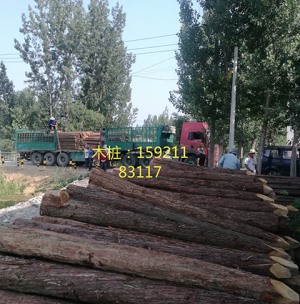Fir has many uses in life, mainly because it is relatively tall and has good wood. Therefore, whether it is engineering materials, furniture panels or fir green poles, fir is used. How to avoid cracking and discoloration when using fir piles?
Cracking of fir piles is mainly due to the lack of moisture in the air. That is, in very high temperatures or dry environments, fir piles with low moisture content are prone to dry cracking. Therefore, attention should be paid to the storage environment of fir piles, maintain the moisture content of fir piles, and avoid Cracking. At the same time, the grain direction of fir piles is difficult to control. The grain direction of fir piles has a certain impact on the drying speed and cracking conditions. We can increase the humidity during storage to keep it fresh and not rotten.
There are many reasons for the discoloration of fir wood piles, such as thermal discoloration and enzymatic discoloration. Therefore, during the storage process, it is necessary to ensure that fir wood piles are stored in a cool and ventilated place to avoid discoloration due to sunlight.
Isupar40 can be used for the preservative of fir wood piles. Isupar40 is a concentrated wood preservative suitable for processing logs, furniture wood, wood, bamboo, rattan, grass, willow and other products for indoor and outdoor decoration.
Instructions for use: When the processing raw material is pine, fir and other softwoods, the product solution is diluted with 6‰ solution and water, that is, 1 times the volume of isupar30 concentrate plus 15 times the volume of water. Pour the concentrated solution into the water and stir slowly evenly. .When the processing material is hardwood and bamboo, the product solution is diluted with 10‰ of water. When the processing material is rattan, the product solution is diluted with water at a ratio of 5‰; when the material to be processed is grass products, the product solution is diluted with 10‰ of water. 2 percent dilution with water.
When processing wood, completely immerse the material to be processed in the finished product solution for 1-3 minutes depending on the cross-section size. When processing bamboo, soak the material to be processed in 15% of the finished product solution for 13-15 minutes. When processing rattan, grass, and willow products When processing, the processed materials should be soaked in the finished solution for 1 minute, or sprayed or sprayed to save the quantity of product. This product cannot handle frozen wood. If the thickness of large wood exceeds 6cm, it needs to be cut after processing, and must be re-cut after cutting. processing.
The normal dosage of finished liquid for various wood guard treatments is about 20-30l\/m3, and the dosage for different wood guard treatments is slightly different.

Related Industry Knowledge
- Methods for preventing corrosion and discoloration of fir wood piles
- Uses of radiata pine logs imported from New Zealand
- How to construct round wood piles
- Correct method of pine pile construction
- Classification of larch wood pile tube holes and transverse, radial and chordal sections
- Precautions for using fir support poles
- How to choose fir wood piles
- The solution to piling fir wood piles in rivers
- Construction of fir wood pile rockery on revetment
- Greening fir pole uses
- Regarding the influence of fir pile knots on the use of fir piles
- What is the proper way to use pine wood piles?
- Measures to ensure the quality of fir wood piles
- Where are pine stakes suitable for use?
- A brief discussion on the production quality and use control of fir wood piles
- Why are fir wood piles so valuable?
- How to drive and maintain pine piles
- The purpose of using fir piles for piling
- How to ensure that fir wood piles are used firmly
- Heat treatment process of fir poles



